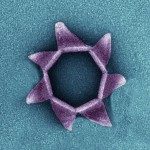Lien vers Pubmed [PMID] – 22808158
PLoS ONE 2012;7(7):e40418
Recent studies suggest that members of the Microviridae (a family of ssDNA bacteriophages) might play an important role in a broad spectrum of environments, as they were found in great number among the viral fraction from seawater and human gut samples. 24 completely sequenced Microviridae have been described so far, divided into three distinct groups named Microvirus, Gokushovirinae and Alpavirinae, this last group being only composed of prophages. In this study, we present the analysis of 81 new complete Microviridae genomes, assembled from viral metagenomes originating from various ecosystems. The phylogenetic analysis of the core genes highlights the existence of four groups, confirming the three sub-families described so far and exhibiting a new group, named Pichovirinae. The genomic organizations of these viruses are strikingly coherent with their phylogeny, the Pichovirinae being the only group of this family with a different organization of the three core genes. Analysis of the structure of the major capsid protein reveals the presence of mushroom-like insertions conserved within all the groups except for the microviruses. In addition, a peptidase gene was found in 10 Microviridae and its analysis indicates a horizontal gene transfer that occurred several times between these viruses and their bacterial hosts. This is the first report of such gene transfer in Microviridae. Finally, searches against viral metagenomes revealed the presence of highly similar sequences in a variety of biomes indicating that Microviridae probably have both an important role in these ecosystems and an ancient origin.

